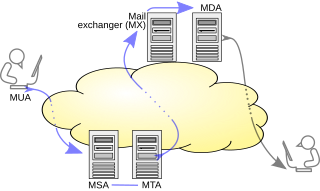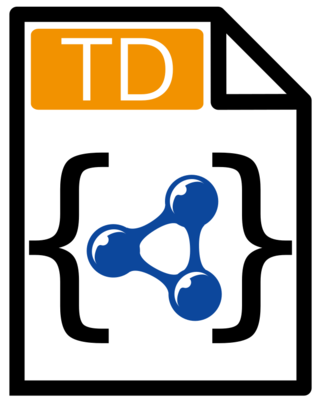
Electronic mail is a method of transmitting and receiving messages using electronic devices. It was conceived in the late–20th century as the digital version of, or counterpart to, mail. Email is a ubiquitous and very widely used communication medium; in current use, an email address is often treated as a basic and necessary part of many processes in business, commerce, government, education, entertainment, and other spheres of daily life in most countries.

An email client, email reader or, more formally, message user agent (MUA) or mail user agent is a computer program used to access and manage a user's email.
8-bit clean is an attribute of computer systems, communication channels, and other devices and software, that handle 8-bit character encodings correctly. Such encoding include the ISO 8859 series and the UTF-8 encoding of Unicode.
An email address identifies an email box to which messages are delivered. While early messaging systems used a variety of formats for addressing, today, email addresses follow a set of specific rules originally standardized by the Internet Engineering Task Force (IETF) in the 1980s, and updated by RFC 5322 and 6854. The term email address in this article refers to just the addr-spec in Section 3.4 of RFC 5322. The RFC defines address more broadly as either a mailbox or group. A mailbox value can be either a name-addr, which contains a display-name and addr-spec, or the more common addr-spec alone.
In information technology, header refers to supplemental data placed at the beginning of a block of data being stored or transmitted. In data transmission, the data following the header is sometimes called the payload or body.
Hashcash is a proof-of-work system used to limit E-mail spam and denial-of-service attacks. Hashcash was proposed in 1997 by Adam Back and described more formally in Back's 2002 paper "Hashcash - A Denial of Service Counter-Measure".
The Extensible Provisioning Protocol (EPP) is a flexible protocol designed for allocating objects within registries over the Internet. The motivation for the creation of EPP was to create a robust and flexible protocol that could provide communication between domain name registries and domain name registrars. These transactions are required whenever a domain name is registered or renewed, thereby also preventing domain hijacking. Prior to its introduction, registries had no uniform approach, and many different proprietary interfaces existed. While its use for domain names was the initial driver, the protocol is designed to be usable for any kind of ordering and fulfilment system.
Sender ID is an historic anti-spoofing proposal from the former MARID IETF working group that tried to join Sender Policy Framework (SPF) and Caller ID. Sender ID is defined primarily in Experimental RFC 4406, but there are additional parts in RFC 4405, RFC 4407 and RFC 4408.
VoIP spam or SPIT is unsolicited, automatically dialed telephone calls, typically using voice over Internet Protocol (VoIP) technology.
Email authentication, or validation, is a collection of techniques aimed at providing verifiable information about the origin of email messages by validating the domain ownership of any message transfer agents (MTA) who participated in transferring and possibly modifying a message.

A message submission agent (MSA), or mail submission agent, is a computer program or software agent that receives electronic mail messages from a mail user agent (MUA) and cooperates with a mail transfer agent (MTA) for delivery of the mail. It uses ESMTP, a variant of the Simple Mail Transfer Protocol (SMTP), as specified in RFC 6409.
In computing, syslog is a standard for message logging. It allows separation of the software that generates messages, the system that stores them, and the software that reports and analyzes them. Each message is labeled with a facility code, indicating the type of system generating the message, and is assigned a severity level.
Sieve is a programming language that can be used for email filtering. It owes its creation to the CMU Cyrus Project, creators of Cyrus IMAP server.

Conversation threading is a feature used by countless email clients, bulletin boards, newsgroups, and Internet forums in which the software aids the user by visually grouping messages with their replies. These groups are called a conversation, topic thread, or simply a thread. A discussion forum, e-mail client or news client is said to have a "conversation view", "threaded topics" or a "threaded mode" if messages can be grouped in this manner. An email thread is also sometimes called an email chain.
Domain-based Message Authentication, Reporting and Conformance (DMARC) is an email authentication protocol. It is designed to give email domain owners the ability to protect their domain from unauthorized use, commonly known as email spoofing. The purpose and primary outcome of implementing DMARC is to protect a domain from being used in business email compromise attacks, phishing email, email scams and other cyber threat activities.
A mailbox is the destination to which electronic mail messages are delivered. It is the equivalent of a letter box in the postal system.
A mailbox provider, mail service provider or, somewhat improperly, email service provider is a provider of email hosting. It implements email servers to send, receive, accept, and store email for other organizations or end users, on their behalf.

The Thing Description (TD) (or W3C WoT Thing Description (TD)) is a royalty-free, open information model with a JSON based representation format for the Internet of Things (IoT). A TD provides a unified way to describe the capabilities of an IoT device or service with its offered data model and functions, protocol usage, and further metadata. Using Thing Descriptions help reduce the complexity of integrating IoT devices and their capabilities into IoT applications.




